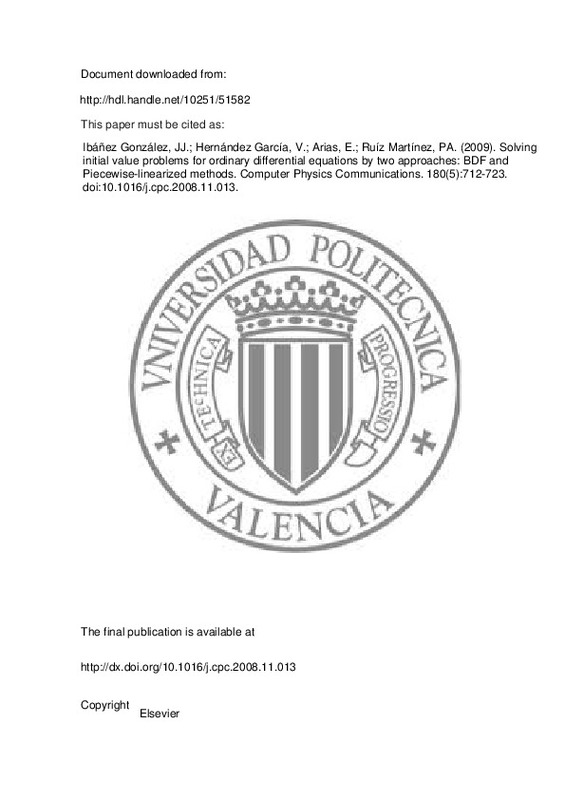JavaScript is disabled for your browser. Some features of this site may not work without it.
Buscar en RiuNet
Listar
Mi cuenta
Estadísticas
Ayuda RiuNet
Admin. UPV
Solving initial value problems for ordinary differential equations by two approaches: BDF and Piecewise-linearized methods
Mostrar el registro sencillo del ítem
Ficheros en el ítem
| dc.contributor.author | Ibáñez González, Jacinto Javier
|
es_ES |
| dc.contributor.author | Hernández García, Vicente
|
es_ES |
| dc.contributor.author | Arias, E.
|
es_ES |
| dc.contributor.author | Ruiz Martínez, Pedro Antonio
|
es_ES |
| dc.date.accessioned | 2015-06-12T06:49:43Z | |
| dc.date.available | 2015-06-12T06:49:43Z | |
| dc.date.issued | 2009-05 | |
| dc.identifier.issn | 0010-4655 | |
| dc.identifier.uri | http://hdl.handle.net/10251/51582 | |
| dc.description.abstract | Many scientific and engineering problems are described using Ordinary Differential Equations (ODEs), where the analytic solution is unknown. Much research has been done by the scientific community on developing numerical methods which can provide an approximate solution of the original ODE. In this work, two approaches have been considered based on BDF and Piecewise-linearized Methods. The approach based on BDF methods uses a Chord–Shamanskii iteration for computing the nonlinear system which is obtained when the BDF schema is used. Two approaches based on piecewise-linearized methods have also been considered. These approaches are based on a theorem proved in this paper which allows to compute the approximate solution at each time step by means of a block-oriented method based on diagonal Padé approximations. The difference between these implementations is in using or not using the scale and squaring technique. Five algorithms based on these approaches have been developed. MATLAB and Fortran versions of the above algorithms have been developed, comparing both precision and computational costs. BLAS and LAPACK libraries have been used in Fortran implementations. In order to compare in equality of conditions all implementations, algorithms with fixed step have been considered. Four of the five case studies analyzed come from biology and chemical kinetics stiff problems. Experimental results show the advantages of the proposed algorithms, especially when they are integrating stiff problems. | es_ES |
| dc.language | Inglés | es_ES |
| dc.publisher | Elsevier | es_ES |
| dc.relation.ispartof | Computer Physics Communications | es_ES |
| dc.rights | Reserva de todos los derechos | es_ES |
| dc.subject | Ordinary Differential Equation (ODE) | es_ES |
| dc.subject | Initial Value Problem (IVP) | es_ES |
| dc.subject | Backward Differentiation Formula (BDF) method | es_ES |
| dc.subject | Piecewise-linearized method | es_ES |
| dc.subject | Diagonal Padé approximation | es_ES |
| dc.subject | BLAS | es_ES |
| dc.subject | LAPACK | es_ES |
| dc.subject.classification | CIENCIAS DE LA COMPUTACION E INTELIGENCIA ARTIFICIAL | es_ES |
| dc.subject.classification | LENGUAJES Y SISTEMAS INFORMATICOS | es_ES |
| dc.title | Solving initial value problems for ordinary differential equations by two approaches: BDF and Piecewise-linearized methods | es_ES |
| dc.type | Artículo | es_ES |
| dc.identifier.doi | 10.1016/j.cpc.2008.11.013 | |
| dc.rights.accessRights | Abierto | es_ES |
| dc.contributor.affiliation | Universitat Politècnica de València. Departamento de Sistemas Informáticos y Computación - Departament de Sistemes Informàtics i Computació | es_ES |
| dc.description.bibliographicCitation | Ibáñez González, JJ.; Hernández García, V.; Arias, E.; Ruíz Martínez, PA. (2009). Solving initial value problems for ordinary differential equations by two approaches: BDF and Piecewise-linearized methods. Computer Physics Communications. 180(5):712-723. doi:10.1016/j.cpc.2008.11.013 | es_ES |
| dc.description.accrualMethod | S | es_ES |
| dc.relation.publisherversion | http://dx.doi.org/10.1016/j.cpc.2008.11.013 | es_ES |
| dc.description.upvformatpinicio | 712 | es_ES |
| dc.description.upvformatpfin | 723 | es_ES |
| dc.type.version | info:eu-repo/semantics/publishedVersion | es_ES |
| dc.description.volume | 180 | es_ES |
| dc.description.issue | 5 | es_ES |
| dc.relation.senia | 35646 |







![[Cerrado]](/themes/UPV/images/candado.png)

